
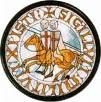
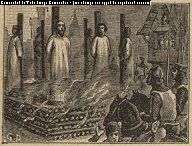
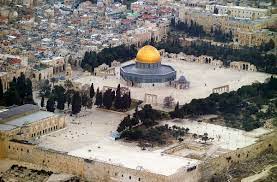






TLW's Templarscope™ (Knights Templar Historyscope) |
By T.L. Winslow (TLW), the Historyscoper™ |
© Copyright by T.L. Winslow. All Rights Reserved. |
Original Pub. Date: Sept. 26, 2021. Last Update: Nov. 25, 2025. |
Westerners are not only known as history ignoramuses, but double dumbass history ignoramuses when it comes to the history of the Knights Templar. Since I'm the one-and-only Historyscoper (tm), let me quickly bring you up to speed before you dive into my Master Historyscope.
The Roman Catholic Poor Fellow-Soldiers of Christ and of the Temple of Solomon AKA the Order of Solomon's Temple AKA the Knights Templar (Templars) was founded in 1119, with HQ in the Temple Mount in Jerusalem.
On July 17, 1099 a secret conclave is held, and Count Raymond of Toulouse asks for the kingship of Jerusalem, and is refused; Godfrey de Bouillon is offered ditto, and declines the title of king but suggests the title "Baron and Advocate (Defender) of the Holy Sepulchre", and is crowned by Peter the Hermit's associate King Tafur (from Calabria?); the secret conclave are mainly monks from Calabria via Godfrey's home in the Ardennes Forest who accompanied him on the Crusade, and move into the new Abbey of Mount Zion (Sion), built at Godfrey's request?; Raymond leaves Jerusalem, never to return, along with the French nobles; the new Latin Kingdom of Jerusalem, based on the cities of Jerusalem (falls in 1187), Antioch (falls in 1268), and Tripoli (falls in 1289) controls only a sliver of territory along the Syrian coast, except for the County of Edessa in SE Anatolia (until 1144), and depends on the Crusades of 1148, 1188, 1202, 1217, 1228 and 1249 for reinforcements, otherwise making little dent on the Muslim world?; the last Crusader fortress of Green Acres, er, Acre falls in 1291; in 1994 the Templar's underground tunnel in Acre is rediscovered by a woman unblocking a sewage pipe under her house.


On Apr. 2, 1118 king (since Dec. 25, 1100) Baldwin I (b. 1058) dies in Egypt after eating some bad fish, and on Apr. 14 his nephew (cousin?) Baldwin II of Jerusalem (1060-1131) (Baldwin of Bourcq) (count of Edessa since 1100) becomes Latin king #2 of Jerusalem (until Aug. 21, 1131); after 300+ pilgrims are ambushed by marauding Saracens between the port city of Jaffa and Jerusalem, and other bands appear outside the walls of Jerusalem, presto-digito heah cum de judge, nine pious Christian knights from N France led by Hugues (Hugh) de Payens (Pajens) (Payns) (1070-1136) and Godfrey (Godefroi) (Gaufred) (Geoffrey) de St. Omer (huge pay-ins and gobs of free saintly lucre?) suddenly arrive at Baldwin II's palace and offer their services, claiming to have taken the vows of poverty, chastity, and obedience, plus another to protect the pilgrims on their journeys between the holy city and the coast; Baldwin bites, and the religious-military order of the Knights Templar (Order of the Poor Knights/Fellow-Soldiers of Christ and the Temple of Solomon) is founded to protect pilgrim routes in the Holy Land by Baldwin II, who grants them a HQ in Jerusalem in the E part of his palace, in the Al-Aqsa Mosque, which stands on the Temple Mount (site of the Jewish Temple of Solomon), under which the Qumran Copper Scroll (discovered in the 20th cent.) claims huge quantities of gold and valuables are buried to keep it from the Romans, who razed it in 70 C.E.; they are also given attached stables big enough to accommodate 2K horses; their seal is two men seated on the same horse, to signify their vow of sodomy, er, poverty; they are a front for the mysterious Order (Priory) of Sion, AKA Order de la Rose-Croix Veritas (Order of the True Red Cross) (Rosicrucians)?; the secular overlord is Count Hugues of Champagne (1074-1125), with spiritual leadership given by French abbot-monk (St.) Bernard of Clairvaux (1090-1153) (#1 spiritual figure in the West, a pope-maker and preventer of Jewish pogroms), who draws up their rule (sanctioned by the Council of Troyes in 1128), based on the Cistercian Rule, with the vows of poverty, chastity, and obedience, and the rule of the canons regular; the order consists of knights (allowed to wear the white mantle with large red Latin cross on the back), chaplains, and men-at-arms (servants); admission is limited to those of noble blood; org. is by commanderies, under a grandmaster; too bad, these monkish Magnificent Nine spend their first nine years, not protecting pilgrims, but locked up inside their HQ, excavating through solid rock in search of the Holy of Holies of the Jewish Second Temple, giving later conspiracy theorists plenty of dream pillow material about how they dug up some magnificent treasure or great secret they used to blackmail the papacy with, maybe some secret documents, or the Shroud of Christ - or the formula for Viagra? In 1118 the aedicula of the Holy Sepulchre in Jerusalem is rebuilt by Bolognese sculptor Renghiera Renghieri.
On Jan. 16, 1120 the Council of Nablus, convened by Jerusalem King Baldwin II and Patriach Warmund establishes 25 canons along with the limits of secular and religious authority, beoming the first written laws of the Latin Kingdom of Jerusalem; Hugues de Payens obtains permission from Baldwin II and Warmund to found the Knights Templar.


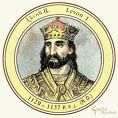
On June 2, 1129 after going on Crusade in 1120 and becoming a close friend of the Knights Templar, and being about to return to Anjou in 1127 when Baldwin II made him an offer he couldn't refuse (after William I Bures and Hugues de Payens returned empty-handed from a mission to France to find her a better hubby), Count Fulk (Fulques) V the Young of Anjou (1089-1143), marries his daughter Melisende (Melusine) (Melisanda) (1105-61) putting him in line to become king-consort of Jerusalem when he dies (1131); after Sunni Damascus ruler (since 1128) Taj al-Din Buri (-1132) orders the massacre of 6K Ismaili Muslims after hearing rumors that they are conspiring with the Crusaders to give them the strategic fort in Banias (named after the Greek god Pan) at the foot of Mt. Hermon N of the Golan Heights in return for control of Tyre, a 60K-man Latin army incl. the Templars head to Damascus with 60K troops, causing Buri to ally with Imad al-Din Zengi of Alepoo to stop them, gaining reinforcements from Hama as well as Turkomen and Arab allies; too bad, a division under constable William I of Bures sets off to gather supplies, and is intercepted by a Muslim force in Buraq (Braq) (Burak) (modern-day Al-Buraq) SE of Hama, ending the Latin offensive before the army reaches the city; meanwhile Fulk leaves Anjou (incl. Maine and Touraine) to his son Geoffrey V Plantagenet, causing Louis VI the Fat to worry about the Anglo-Norman menace.
On Nov. 25, 1177 a Crusader force of 450 knights (80 Templars) and several thousand infantry under Baldwin IV, Raynald de Chatillon, and Odo de St. Amand defeats Saladin and his 9K-26K Ayyubids at the Battle of Montgisard, attacking after his army begins to disperse and securing a rare Latin V.
On June 10, 1179 a Latin army led by Baldwin IV and Raymond of Tripoli is defeated by the Ayyubid army Saladin at the Battle of Marj Ayyun (Ayyoun); Templar master Odo of St. Armand is blamed for his rash attack.

Where's the underground spaceship? On Feb. 10, 1185 London's Caen-stone circular Temple (Templar) Church on Fleet St. in London is consecrated by Latin Patriarch of Jerusalem (1180-7) Heraclius (Eraclius) (1128-91) of Jerusalem; damaged by the Luftwaffe in 1940 then restored; Heraclius then consecrates Clerkenwell Priory in London, founded in 1100 by Lord Jordan Briset as the HQ for the Hospitalers; burned down by Tyler's Rebellion in 1381, and rebuilt in 1504; after Henry II holds an aulic council in it, Heraclius tries to talk him into sending troops for a new Crusade, but can't talk the barons into allowing Henry to lead them personally, even in exchange for the crown of Jerusalem, causing him to utter the soundbyte: "Here is my head.... treat me as you did my brother Thomas Becket. It doesn't matter to me whether I die by your orders or in Syria by the hands of infidels, for you are worse than Saracens."






On May 1, 1187 the Battle of Cresson sees the Knights Templar and Hospitalers defeated by the Ayyubids led by Saladin's son al-Afdal. Beating me, beating me down, into the ground, falling away from me? Crusaders from the Kingdom of Jerusalem break the truce and attack a caravan carrying the sister of cool all-black-wearing Kurdish Ayyubid sultan of Egypt and Syria (since 1171) Saladin (Salah ad-Din Yusuf ibn Ayyub) (1138-93), causing him to begin a holy war (jihad) against the Crusaders, invading the Kingdom of Jerusalem with his nephew Taqi al-Din and Gok-Bori and 200K Saracen troops (aided by Yaqub al-Mansur of Spain), then sieging the city of Tiberias; Byzantine Emperor Isaac I'm-No-Angelus allies with Saladin to avoid messing up his hair, and a relief army is organized by the Latins, led by Jerusalem king Guy de Lusignan, Count Raymond III of Tripoli (1140-1187), and Balian of Ibelin (1141-93) (not a blacksmith like Orlando Bloom in the 2006 Ridley Scott film "Kingdom of Heaven"?), but it gets trapped on July 4 at the Battle of the Horns of Hattin (Karnehatin) near the Sea of Galilee 6 mi. from Tiberias, and the heat-stroked Latin army is wiped out, with only 3K of 20K Christians escaping Saladin's 30K troops; after personally beheading Raynald of Chatillon, Saladin spares Guy de Lusignan with the soundbyte "Real kings don't kill each other"; the True Cross is fixed upside down on a lance and sent to Damascus, and several of Saladin's men leave his army to take their Frankish POWS with them; on July 5 Saladin captures Tiberias, allowing Countess Eschiva, Princess of Galilee (1118-87) safe passage to Tripoli with her family, followers, and possessions; on July 6 Saladin gives the Templar and Hospitaler POWs the chance to convert to Islam, and some become devout Muslims, while the rest choose martyrdom, incl. Hospitaler St. Nicasius (1135-87); Guy de Lusignan is taken as a POW to Damascus and held for ransom for a year; after Maimonides of Cairo talks him into it, Saladin permits Jews as well as Muslims to return and settle; on July 29 Saladin takes Sidon; plug-ugly Crusader Reginald of Sidon (-1202) (who speaks Arabic and grooves on Arabic lit., causing the other Crusaders to distrust him) bugs out of the rear of the Battle of Hattin and flees to Tyre, attempting to negotiate its surrender to Saladin until Conrad of Montferrat arrives and kicks him out, causing him to flee to the Crusader stronghold of Beaufort after finding that Saladin has captured Sidon, where he holes-up until 1190. On Sept. 20 after conquering Acre, Ibelin, Nablus, Toron, Sidon, Beirut, Ramla, and Ascalon, giving Balian time to organize the city defenses and create 60 new knights from the burgesses to supplement the 2-14 he had, Saladin begins the Siege of Jerusalem, and after knocking down some walls but finding the Christian diehards prepared to destroy the city and kill each other rather than surrender, he shows why he's a wise and honorable sport and permits the fashion model Queen Sibylla, the Christian defenders, and most of the Christian pop. to leave with safe passage, ransoming 18K people (incl. 7K men) for 30K bezants (with two women or 10 children being equal to one man for the same price), the remaining 15K being forced into slavery after a 40-day payment period lapses; on Oct. 2 Balian of Ibelin hands over the keys to the Tower of David, and the Christian losers march away in three columns, with Balian and Patriarch (since 1180) Heraclius (Eraclius) (1128-91) leading the last one on Nov. 20, ending the Latin Kingdom of Jerusalem (founded 1099); although he does not sack the city, Saladin ravages the Church of the Holy Sepulchre and turns it into a mosque, stripping the gold reliquaries and carrying away cartloads of treasure, later returning it to the Christians after an agreement with Byzantine emperor Isaac II Angelus; the hostages end up in Tripoli; Heraclius and Sybilla take refuge in Antioch; Saladin goes on to capture all Crusader territory except the seaport of Tyre, which remains in the hands of the Franks, and the cities of Antioch and Tripoli. On Sept. 27 after Stefan I Nemanja of Serbia attacks the Repub. of Dubrovnik, and Norman reinforcements arrive to help them, he signs a peace treaty declaring eternal peace, with nominal rule by Serbian kings, and the statehood of the repub. guaranteed. On Oct. 20 Pope (since 1185) Urban III allegedly dies of a broken heart after hearing the bad news from the Holy Land at Ferrara while en route to excommunicate HRE Frederick I Barbarossa for his antics, and on Oct. 21 Cardinal Alberto de Morra is elected Pope (#172) Gregory VIII (-1187), but he dies on Dec. 17 after only 1 mo. 27 days after proclaiming the Third Crusade and making overtures to reconcile Frederick I with the Church so he can be free to kick Muslim butt and get the Holy Sepulchre back, and on Dec. 19 Roman-born Paolo Scolari is elected Pope (#173) Clement III (-1191), immediately seeking to heal the old rift between the papacy and the Roman pop.
In Jan. 1188 after hearing of the bad news from Jerusalem from the archbishop of Tyre, France and England make a truce on the battlefield, and the archbishop persuades Philip II Augustus of France, Henry II of England, and his son Richard I Lionheart to pledge themselves to a crusade on the spot, declining the crown of Jerusalem but levying the Saladin Tithe (Aid of 1188) (a tenth of the value of incomes and chattels, subject to adjudication by a local jury) in aid of the Holy Land, becoming Henry II's 2nd taxation of personal property; in Feb. Pope Clement III triumphantly returns to Rome, and begins massing Christian soldiers against the Muslims for his delightful blood-drenched Third Crusade (ends 1192), the first to feature personal insignia on shields; Guy de Lusginan is released by Saladin, gains naval reinforcements from Pisa and sieges Acre in Aug., but is unsuccessful after Saladin's troops siege them; Saladin uses Damascus as his HQ during the Crusade; during the negotiations in the Champ Sacre (Sacré) (Sacred Field) of Gisors in Normandy, Henry II and his men (incl. Richard I Lionheart) hunker down under the 800-y.-o. Elm of Gisors, leaving Philip II and his men in the sun, ending in a battle in which the French take the elm and cut it down; after this incident, the Order of Sion splits ranks with its child the Templars, with Jean de Gisors (1133-1220) (vassal of Henry II and Richard I until 1193, who owns Titchfield Manor in Hampshire, England, and allegedly met Thomas Becket at Gisors in 1169) becoming the first Grandmaster (Nautonnier) (Pilot) of the Order of Sion (until 1220), which changes its name to the Priory of Sion, and makes every grandmaster assume the name Jean or Jeanne to indicate an esoteric successor to St. John, with Jean de Gisors calling himself Jean II; the Priory of Sion adopts the subtitle Ormus (Ours is Fr. for bear, Orme is Fr. for elm, Or is Fr. for gold), and begins calling itself the Order of the True Red Cross (Rose-Croix Veritas) (Rosicrucians?).



In spring 1191 Crusaders Richard I Lionheart of England, Philip II of France, incl. Templars and Hospitallers, Angevins, Bretons, and Flemings under James (Jacques) (Jacob) of Avesnes (1152-91) set sail to attack the Holy Land, and Richard I Lionheart stops in Rhodes to drop off his sister Joan Plantagenet (1165-99) (widow of William II of Sicily) to talk Sancho VI of Navarre into agreeing to give him his eldest daughter Berengaria of Navarre (1165-1230) in marriage so that he can get his hands on Navarre (dumping Alys, his betrothed), and when they leave to follow him and get shipwrecked by a storm on Cyprus, hot-headed Cyprus despot (since 1184) Isaac Comnenus (Komnenos) of Cyprus (1155-96) captures them, pissing-off Richard and causing him to turn around (or get blown there by a storm), land in Lemesos (Limassol) on May 6, conquer it, then kick Comnenus' butt at the Battle of Tremetusia, and trick him into surrendering at his Kantara Castle on Cape St. Andreas on the Karpas Peninsula by promising not to put him in irons, after which he uses silver chains (ha ha), and turns him over to the Knights of St. John, who keep him in Margat (near Tripoli) until 1194, after which he travels to the sultanate of Rum to gain support, and ends up poisoned; Richard then marries Berengaria on May 12 in Limassol at the Chapel of St. George, the wedding attended by Prince Levon of Cicilian Armenia (ever eager to get noticed so they can promote him to king?), and decides to use Cyprus as a Crusader supply bridge to Jerusalem; Richard buys two Arabian horses in Cyprus, which he puts gold bridles on, causing them to be called brigliadores; Comnenus' daughter "the Damsel of Cyprus" joins Richard's court, and travels back to England with Joan; meanwhile Egyptian sultan Saladin conquers Haifa, and dismantles the city of Ashkelon on the Mediterranean coast; in Apr. the French under Philip II Augustus and Conrad of Montferrat arrive at Acre after Philip's nephew Count Henry II of Champagne beats him to it, then erect huge siege engines; the English under Richard I Lionheart arrive on June 9 and take contol of the siege, using sappers to undermine the walls; Richard offers his men first one then four gold coins to race across the open plain dodging Saracen bowmen and hot oil-slingers and pull a single stone from Acre's thick wall; on July 12 after their supplies run out, Acre, AKA Ptolemais surrenders to the Crusaders; Philip II gets sick and accuses Richard I of trying to poison him, and returns to France, making final capture of Jersualem impossible, as if that would stop them?; the Crusaders demand the delivery of 1.6K Christian captives, payment of 200K dinars, delivery of the True Cross, and allow the pop. of Acre to leave on the condition that they carry nothing but the clothes on their backs; too bad, on Aug. 11 an exchange of POWs and moolah is aborted after the Crusaders quibble; on Aug. 20 after Saladin takes too long to respond, Der Fuhrer Richard I orders the execution of 2.7K Muslim hostages, "avenging their fallen comrades who had died at Acre", slicing open their bellies looking for swallowed treasure; Saladin responds in kind, ordering the execution of all 1.6K Christian POWS, and hiding the True Cross (under the doorway of the Mosque in Damascus?); Isaac Comnenus of Cyprus surrenders to Richard I, who imprisons him in the Syrian castle of Markab; after Richard I unsuccessfully backs his vassal Guy de Lusignan for king of Jerusalem over the German candidate Conrad of Montferrat, Guy gives the Hospitallers a portion of the tower in Acre, and Richard I sells Cyprus to Guy and the Knights Templar, and Guy becomes king of Cyprus next year (until 1194); the Crusaders rule Acre for the next cent; meanwhile after Richard I insults Duke Leopold V of Austria by throwing his banner into the acres of mud of Acre, the latter invents the red-and-white triband Austrian Flag when there is a white strip of cloth found under his bloody tunic after the battle; in Aug. knowing they need to control the port of Jaffa before taking Jerusalem, the Crusaders leave Acre and go S, and, after being harassed all along the way by archers finally defeat Saladin on Sept. 7 at the Battle of Arsuf near Jaffa, remembering the lessons of the Horns of Hattin and taking measures against heat exhaustion and thirst, although they are tormented at night by tarantulas; on Aug. 30 as they approach Caesarea, the rear guard under Duke Hugh III of Burgundy is cut off, but Richard rallies his troops to save them with the cry "Sanctum Sepulchrum Adjuva!" (Help us, Holy Sepulchre!); during the battle the Muslims are sorely pressing the Crusaders, until Hospitaler grandmaster Garnier de Nablus disobeys Richard's orders and goes beserk and leads a charge, which Richard decides is their big chance to turn the tide, after which Richard "advanced with untiring sword strokes, cutting down the unspeakable race as if he were reaping the harvest with a sickle, so that the corpses of Turks he had killed covered the ground everywhere for the space of half a mile"; Saladin's myth of invincibility is shattered, with 7K Muslims killed vs. 700 Christians (according to the Christians); the slap-happy Crusaders then recapture St. Peter's old Dorctown of Jaffa, although Big J is out of their grasp and they decide to cut off Saladin's main supply base of Egypt instead.


On Apr. 2, 1192 Richard I Lionheart of England sends his rep. Henry II of Champagne from Acre to Tyre to inform Conrad of Montferrat of his election as Latin king of Jerusalem, but on Apr. 28, a few days after Henry returns Conrad is murdered by two hashashin in Tyre, and when Henry is sent back to Tyre two days later to help with his coronation, he finds a funeral instead, and eight days later after supposedly wowing her with his virility (being 20 years younger than Conrad) he marries Conrad's pregnant widow Isabella of Jerusalem (1172-1205) (daughter of Amalric I and Maria Comnena), and becomes king of Jerusalem (until 1197); on July 29 the Crusaders, incl. 80 knights and 2K Genoese crossbowmen recapture Jaffa from 7K Muslim cavalry troops, and reach Jerusalem but fail to capture it, and on Sept. 2 after a trial balloon proposal of a marriage of Saladin's brother to Richard I's sister Joan, with Big J invested to the lucky groom, the Crusaders give up fighting for Christ and agree to the 3-year Peace of Ramlah (Ramleh) with Dinner Salad, er, Saladin, giving the Christians a strip of steak, er, coastal territory between Jaffa and Acre, plus access to Jerusalem, and it takes until 1229 for the Christians to recapture Big J; Guy de Lusignan resigns his title of king of Jerusalem, but still has the serviceable launchpad island of Cyprus (until 1194); meanwhile new king Henry II of Champagne meets with the Assassins in their fortress stronghold of al-Khaf, smokes, er, watches two of the fanatics kill themselves to prove what robots they are, then signs a treaty with their grandmaster, causing speculation of a plot with Richard to knock off Conrad all along - get my caddy and my calculator? On Oct. 9 Richard I returns from the Crusades, but suffers from seasickness and decides to cross the Alps disguised as a Knight Templar; too bad, he is captured on Dec. 11 at an inn near Vienna by his enemy Duke Leopold V of Austria (1157-94), then imprisoned (in violation of an unwritten law that Crusaders can't be detained) by orders of grudge-bearing HRE Henry VI in a dark castle in Durnstein (Durrenstein) on the Danube River on Dec. 21 (until Feb. 4, 1194); after his return to France Philip II Augustus begins scheming with Richard's brother John Lackland, getting Normandy handed over by secret treaty; Philip II tries to get Richard I handed over to him as his prisoner, but is refused.


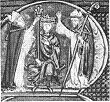
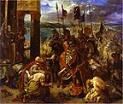
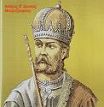

Everyone wants an old school lord and master? On Jan. 1, 1204 after some Crusaders attack a mosque in Constantinople, causing citizens to confront them, and a fire ravages a section of the city, causing the Latin pop. to take refuge in the Crusader camp, Byzantine emperor Alexius IV launches fire ships at the Venetian fleet, which they stop; on Jan. 25 after pissed-off Greeks mad about paying money to stinkin' heretic Latins start a riot, Alexius III's son-in-law Alexius V Ducas (Alexios V Dukas) Mourtzouphlos (Gr. "bushy eyebrows"?) (1140-1204) sees his chance and has Alexius IV Angelus (b. 1182) and Isaac II Angelus (b. 1156) arrested and killed on Jan. 27/28, and is crowned as Roman Byzantine emperor #161 on Feb. 5 (until Apr. 12), ending negotiations with the Crooked Crusaders and refusing to make any more payments, while strenghtening the city defenses, personally leading a surprise attack on the Crusader camp and beating back a Crusader assault on Apr. 9; too bad, on Apr. 12-13 soldiers of the Fourth Crusade, comprised of French nobles and their followers, as well as Venetians and Flemings (OE "men from the lowlands"), surprise, capture, and Sack the Hell Out of Constantinople, then rub this date rape in by declaring it a marriage, announcing the Latin Empire of the East (Romania), based in Constantinople (ends 1261), conveniently cutting Venice's rival "La Superba" Genoa (who is backed by Greece) out of the trade routes; Alexius V ducks out and escapes to Mosynopolis in Thrace, HQ of deposed emperor Alexius III, and marries his daughter Eudocia Angelina, until his new father-in-law turns on him and has him blinded and cast out, after which the Crusaders under Thierry de Loos capture him in Nov., bring him back to Constantinople, condemn him for treason against their puppet Alexius IV, and throw him from the top of the Theodosian Column in Dec., and he becomes the last Byzantine emperor in Constantinople until 1261; Boniface of Montferrat captures Boukoleon Palace on the shore of the Sea of Marmara, discovering a gaggle of women incl. Empress Margaret, daughter of Bela II of Hungary, whom he marries; happy camper Pope Innocent Three Times is the Charm declares the Great Schism ended, but the icon-loving Greeks refuse to give up that easy, and the result is its permanent hardening within two generations as the rapee tries to get loose and turn states' evidence or set the bed on fire?; a council composed equally of Crusaders and Venetians divides the Eastern Empire, giving the imperial crown to Count (since 1194) Baldwin of Flanders, crowning him Baldwin I (1172-1205), Latin emperor #1 of the East on May 16 in the Hagia Sophia in Constantinople (until 1205); Thomas Morosini (1170-1211) of Venice replaces the Greek patriarch, becoming the first Latin patriarch of Constantinople (until July 1211); Boniface of Montferrat is made king of Salonika (Thessalonica), which incl. part of Thrace, Macedonia, and Thessaly; the rest of the empire is split up among various baron vassals; Venice receives three-eighths of the city, plus Adrianople, Gallipoli, Crete (until 1669), Euboea (a triarchy), Naxos, Andros, the SW tip of the Peloponnesus (Coron and Modon), Durazzo and other posts on the coast of Epirus, the Ionian islands, and some islands in the Aegean; some believe the Shroud of Christ is taken back to France among the huge loot of holy relics by Knight Templar Richard de Clare, 4th Earl of Hertford (1162-1218), along with many priceless treasures melted down into coins; the looting happened because the Venetians, who supplied the ships took so long that many Crusaders made their own way and thus underbooked them, causing them to look for a way to get paid?; actually the long-simmering animosities between Venice and Constantinople, exacerbated by religious rivalry and that old Greek-Roman thang helped to breed a bank-robber-in-the-family mentality?; Pope Innocent III professes to be (really is?) shocked (innocent?), along with most of Europe, and excommunicates the Venetians for it, but makes hay of his opportunity to Latinize the Greek Orthodox Church, hardening the schism further; in 1207 after living through the Apr. 13, 1204 battle for Constantinople between the W Euro Roman Catholics and Byzantine Orthodox Catholics, French marshal of Champagne Geoffrey of Villehardouin (Geoffroi de Villehardouin) (1160-1212) begins writing De la Conquete de Constantinople (On the Conquest of Constantinople), a 3rd person memoir in lovely French, becoming one of the first works of French prose - another day here in the park, I think it was the Fourth of July, or, what a lady what a night, or, get that icon down?
On Jan. 15, 1208 a knight working for Count (since 1194) Raymond VI of Toulouse (1156-1222) kills papal legate Pierre de Castelnau, and Pope Innocent III deposes him for it; the pesky Byzantine heretics seemingly in hand, Pope Innocent III first vainly appeals to Philip II of France, who refuses to get involved, then proclaims a Crusade against #2 on his list, the Cathars (Albigensians) (Catharists of Albi) ("Western Buddhists"), a sect of too loose heretical dualistic vegetarians in S (Provencal) France centered in Toulouse, which started out as a reaction against clerical corruption but was joined by the nobles as a way to appropriate Church lands, becoming fabulously wealthy and getting mixed-up with the Templars; believing that Christ was a prophet of Amor (love), they refused to make a big deal of the Crucifixion, which they regarded as an emblem of Rex Mundi (Lord of the Material World), which has twisted Amor into its opposite, Roma, also denying the sacraments of Baptism and Communion, and practicing birth control and abortion, accepting reincarnation and the female principle, allowing women parfaits (priests), and insisting on direct personal contact with God rather than mere faith; looking for a get-out-of-purgatory-free card, Duke Eudes III of Burgundy steps up to the plate and organizes a campaign against the Cathar strongholds in Languedoc next year, starting the Albigensian Crusade (ends 1229). On July 22, 1209 after 30K Crusader knights and foot soldiers under Simon de Montfort storm Languedoc in SE France along the Garonne River, the most advanced and civilized section of France, known for religious tolerance along with mass abandonment of Roman Catholic faith, 15K-20K are massacred in Beziers (Béziers) after an officer allegedly asked a papal rep how to distinguish Cathar heretics from true Roman Catholic believers, and was told "Kill them all, God will recognize his own"; they then do ditto to Perpignan, Narbonne, Carcassone, and Toulouse.
On July 14, 1229 HRE Frederick II defeats imperial bailiffs outside Nicosia and seizes Cyprus from regent John of Ibelin (1179-1236), old Lord of Beirut, who flees with his family to Palestine and sets up shop in Jaffa, vowing to kick Hohenstaufen butt, launching the the War of the Lombards (Imperialists) (Ibelin War) between the reps of HRE Fredrick II, supported by the Knights Hospitaller and Teutonic Knights vs. the native aristocrats led by Ibelins and Montforts, supported by the Knights Templar (ends 1243).
On Oct. 17-18, 1244 a major Latin army (allied with local Ayyubid princes) is destroyed by the Egyptians and their allies near Gaza in the Battle of La Forbie; the three Christian military orders have their butts kicked bigtime by the Allah Akbars, and 312 of the 348 Knights Templar are KIA, incl. grandmaster Armand de Perigord (Hermann de Pierre-Grosse) (b. 1178); Louis IX the Saint of France becomes a Knight Templar, gets sick, and swears that if he recovers he will start the Seventh Crusade to stop the Egyptian attacks; he does, so guess what, he does the saintly thing and takes up the Cross; meanwhile the reaction among Christians is to revert to Millennium Fever, taking to the soapbox to whip the masses up to go on YAC (yet another crusade) - maybe Jeezy just doesn't care about the *!?*! place, no matter how much the tourist companies are hurting?
In 1256 pissed-off at losing Ascalon, the Mamluks siege Jaffa, but John of Ibelin returns from Ascalon and defeats them, giving up control of Jerusalem to his cousin John of Arsuf (Ibelin) (1211-58). In 1256 the Venetian-Genoese (Hundred Years) War between the maritime repubs. of Venice and Genoa begins when the Venetians are evicted from Tyre, and try to move into Acre onto land owned by the Monastery of St. Sabas, which Genoa claims, starting the War of St. Sabas (Saba) (ends 1270) in Acre, with John of Ibelin, count of Jaffa, and the Knights Templar supporting the Venetians, and Philip of Monfort, John of Arsuf, and the Knights Hospitaler supporting the Genoese, who win early Vs until the repub. of Pisa signs a 10-year military alliance with Venice.
In 1258 the Venetians under adm. Lorenzo Tiepolo break through the harbor chain in Acre and defeat the Genoese navy, capturing the disputed St. Saba monastery, then after the 800 Genoese soldiers and crossbowmen hold their quarter of the town, Tiepolo begins a blockade, after which in Aug. John of Arsuf, hoping to aid Genoa signs a treaty with the city of Ancona granting commercial rights in Acre, but it backfires when John of Ibelin and John II of Beirut turn them to Venice's side, leaving only Philip of Monfort on the Genoese side, but after his 380 men are defeated, on Oct. 16 a peace treaty is signed by the Templars, Hospitallers, and Teutonic Knights, and the tired Genoese leave their acre in Acre for Tyre, continuing the fight.
On Apr. 4-May 18, 1291 the last Crusader (Frankish) state of Acre (Saint-Jean d'Acre) (Akka) in Syria is sieged and captured by the Mamluks, followed in May by Tyre; the Christian Crusades (begun 1095) end miserably with the expulsion of the Crusaders from the Middle East (Palestine), and the Mamluks in control of all of Egypt and Syria; Pope Nicholas IV calls upon all Christian princes to pray for all the needless deaths, er, take up arms against the Muslims one more time, and for synods to discuss the advisability of uniting the Knights Templar and the Knights of St. John, whose catfights he partly blames for the loss of the Ptolemais; in Aug. he sends a letter to Persian Mongol khan Arghun informing him of plans of Edward I of England to lead another Crusade to recapture the Holy Land, stating that it could only be successful with the help of the "powerful arm" of the Mongols, and asking Arghun to receive Christian baptism and march against the Mamluks; after Arghun dies in Mar. 1291, followed by Nicholas IV in Mar. 1292, Edward I sends Geoffrey de Langley to Persian Mongol khan Gaikhatu, leaving from Genoa and arriving in Tabriz, then returning to Genoa; "Had the Mongol alliance been achieved and honestly implemented by the West, the existence of Outremer would almost certainly have been prolonged; the Mameluks would have been crippled if not destroyed; and the Ilkhanate of Persia would have survived as a power friendly to the Christians and the West" (Sir Steven Runciman, A History of the Crusades, p. 402); meanwhile the Knights of St. John are transferred to conveniently-located Cyprus; too bad, the Templars end up back in Europe with no coverstory and too much land and wealth, causing a ton of pissed-off royals who owe them money to get ideas? - they got sixteen years left?

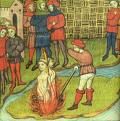
On July 24, 1307 the Knights Templar hold a gen. chapter meeting in Paris; pocket pope Clement V writes to his boss Philip IV on Aug. 24 with a sealed mandate, not to be opened until dawn on Oct. 13 (Fri.), telling of his vision that the Knights Templar are heretics and blasphemers, devil worshipers, homosexuals, sodomites, defilers of Christ and other blimey, and that God had told him to cleanse the Earth by rounding them all up and torturing them until they confess (roasting of the feet is particularly favored?); too bad, at midnight just before the big day dawns, Templar ships under the Admiral of the Fleet leave from La Rochelle, carrying all their big secret documents, portable treasures, and other neat stuff; on Oct. 13 (Fri.) (Oct. 21 Gregorian), AKA Black Friday the 13th, Templar grandmaster (since 1297) Jacques de Molay (1244-1314) is arrested in the Paris Temple by dozens of seneschals, accompanied by Philip IV, who gets pissed-off at not finding their treasure or documents; meanwhile the whole Templar Order throughout France is arrested (15K men), and its assets seized by the crown; the Order is charged with 127 blasphemous crimes; some Templars escape to Argyll, Scotland, where the war with England causes the papal bulls dissolving the order to never be proclaimed, and their allies the Freemasons protect them, admitting them into their lodges under the Accepted Rites of Freemasonry; others flee to Jewish-friendly Spain, Portugal, and Poland; de Molay's deputy Geoffroy de Charnay (1251-1314), and a few others barely survive under cruel chief torturer Gaspard Chaix, only to be burned on Mar. 18, 1314 after they refuse to give up the big secrets of where the loot is?; tortures incl. having heavy weights attached to their testicles, being jerked over heavy beams, held in dungeons for months, feet-roasting et al. - you can't take the Fifth with Clement the Fifth? On Aug. 8, 1308 Pope Clement V summons witnesses for the Templar Trials in Poitiers, bringing 72 Templars to testify about worshiping Head 58 AKA Baphomet (Muhammad?) (Sofia after applying the Atbash Cypher?) (the Shroud of Turin or Mandylion?); on Aug. 17 senior officers of the Templars are interviewed by three cardinals in Chinon; on Sept. 13 English common law stops a pair of French inquisitors arriving in England from prosecuting the Templars, causing Pope Clement V to write to Edward II: "We hear that you forbid torture as contrary to the laws of your land. But no state law can override canon law, our law. Therefore I command you at once to submit those men to torture", causing Edward II to flop, holding the first English tribunal of the Inquisition, and becoming the last use of torture in England until Queen Bloody Mary in 1553-8; the tribunal suppresses the Templar Order and seizes its assets for Edward II, making him and Philip IV the two kings who make out the best?; in Oct. 2007 the Vatican announces the release of the trial documents, showing that they were absolved of heresy charges but burned anyway - and all those Vatican bureaucrats kept their silence all that time?
On May 12, 1310 54 Knights Templar are burned in France as the Order of Knights Templar is ruthlessly extinguished by Philip IV of France allied with the Church; 115 are eventually burned after their feet are roasted over a fire to make them confess; those lucky enough to survive end up as street beggars wearing their charred feet around their necks.
In 1310 the Knights of St. John (Hospitalers) finish conquering Rhodes, becoming the Knights of Rhodes, valiantly resisting expulsion until 1522 while engaging in a naval crusade, which the Ottomans and Venetians regard as pure high-seas piracy run by pirates bearing crosses.


On Mar. 18, 1314 after years of fruitless attempts to torture out the whereabouts of their treasure, 39 more Knights Templar are burned in Paris, incl. grandmaster #23 (last) Jacques de Molay (Molai) (b. 1244) and his deputy Geoffroi de Charnay (Charney) (Charny) (b. 1251), preceptor of Normandy; they are slow-roasted over smokeless charcoal, taking hours to die?; in the flames de Molay (who had been tortured into a confession of heresy and given life in priz earlier that day, only to immediately retract it and ordered burned) protests the innocence of the Templar Order, and calls down Philip IV and Pope Clement V for their injustices, launching the Templar Curse, and sure enough they both croak later this year, popey going first in only 33 days?
In Feb. 1312 Philip IV appears before the Council of Vienne and vehemently demands the suppression of the Knights Templar; on Mar. 22 Pope Clement's bull Vox Clamantis dissolves them, and transfers their property to the Hospitalers, except in Spain and France, where the crown keeps it; Philip makes the Templar treasury a section of his royal finance admin.; excommunicated Robert I the Bruce welcomes the Templars to Scotland; Dinis I of Portugal protects the Templars in his territory, and absorbs their holdings into his new Order of Christ; on Apr. 4 the Council of Vienne proclaims a new Crusade.
On Mar. 18, 1314 after years of fruitless attempts to torture out the whereabouts of their treasure, 39 more Knights Templar are burned in Paris, incl. grandmaster #23 (last) Jacques de Molay (Molai) (b. 1244) and his deputy Geoffroi de Charnay (Charney) (Charny) (b. 1251), preceptor of Normandy; they are slow-roasted over smokeless charcoal, taking hours to die?; in the flames de Molay (who had been tortured into a confession of heresy and given life in priz earlier that day, only to immediately retract it and ordered burned) protests the innocence of the Templar Order, and calls down Philip IV and Pope Clement V for their injustices, launching the Templar (De Molay) Curse, and sure enough they both croak later this year, popey going first in only 33 days?

In 1334 the Black Death strikes in China's NE Hopei Province, then sweeps along the trade routes to Europe by 1347; "Constantinople, summer of 1334. It marched through the streets, the sewers. It left the city by oxcart, by sea to kill half of Europe. The rats, rustling and squealing in the night as they too died... the rats!" - Eyewitness Flint in 1969 Star Trek episode Requiem for Methuselah - could it be a Templar plot to get even? On Sept. 14, 1334 (Wed.) the naval Battle of Adramyttium (Edremit) sees the 20 Venetian galleys under Pietro Zeno (-1345) defeat emir Yakhshi of Karasi, reducing Turkish raids in the Aegean Sea, setting things up for the promised new Crusade; too bad, on Dec. 4 Pope (since 1316) John XXII (b. 1249) dies, and on Dec. 20 former Cathar-broiling inquisitor (Cistercian monk and bishop of Pamiers) Jacques Fournier is egg-lected Pope (#196) Benedict XII (-1342), becoming Avignon pope #4, dropping plans for the Crusade, allowing Umur Pasha to resume his attacks next year, starting with Morea, and the Turkish menace on the E Mediterranean blossoms until new pope Clement VI is elected in 1342, with plundering of the Aegean islands and Greek mainland, incl. Crete.
In the 1960s the Sovereign Military Order of the Temple of Jerusalem (SMOTJ) is founded under the umbrella of the Ordo Supremus Militaris Templi Hierosolymitani, which was formally recognized by Napoleon in 1805; by 2010 it reaches 5K members, 1.5K from the U.S., which has 33 priories from Ariz. to Wisc.